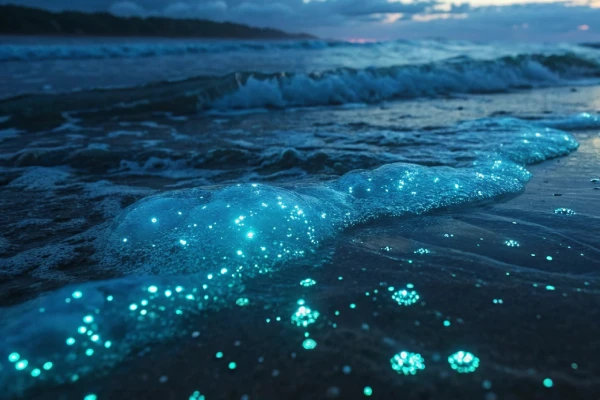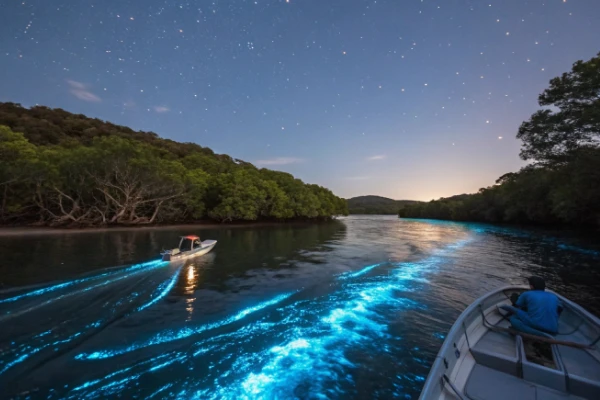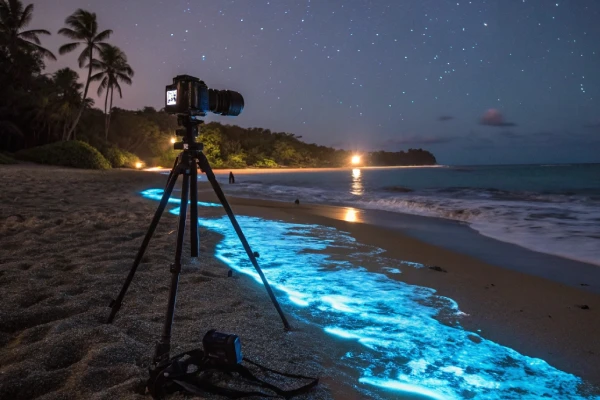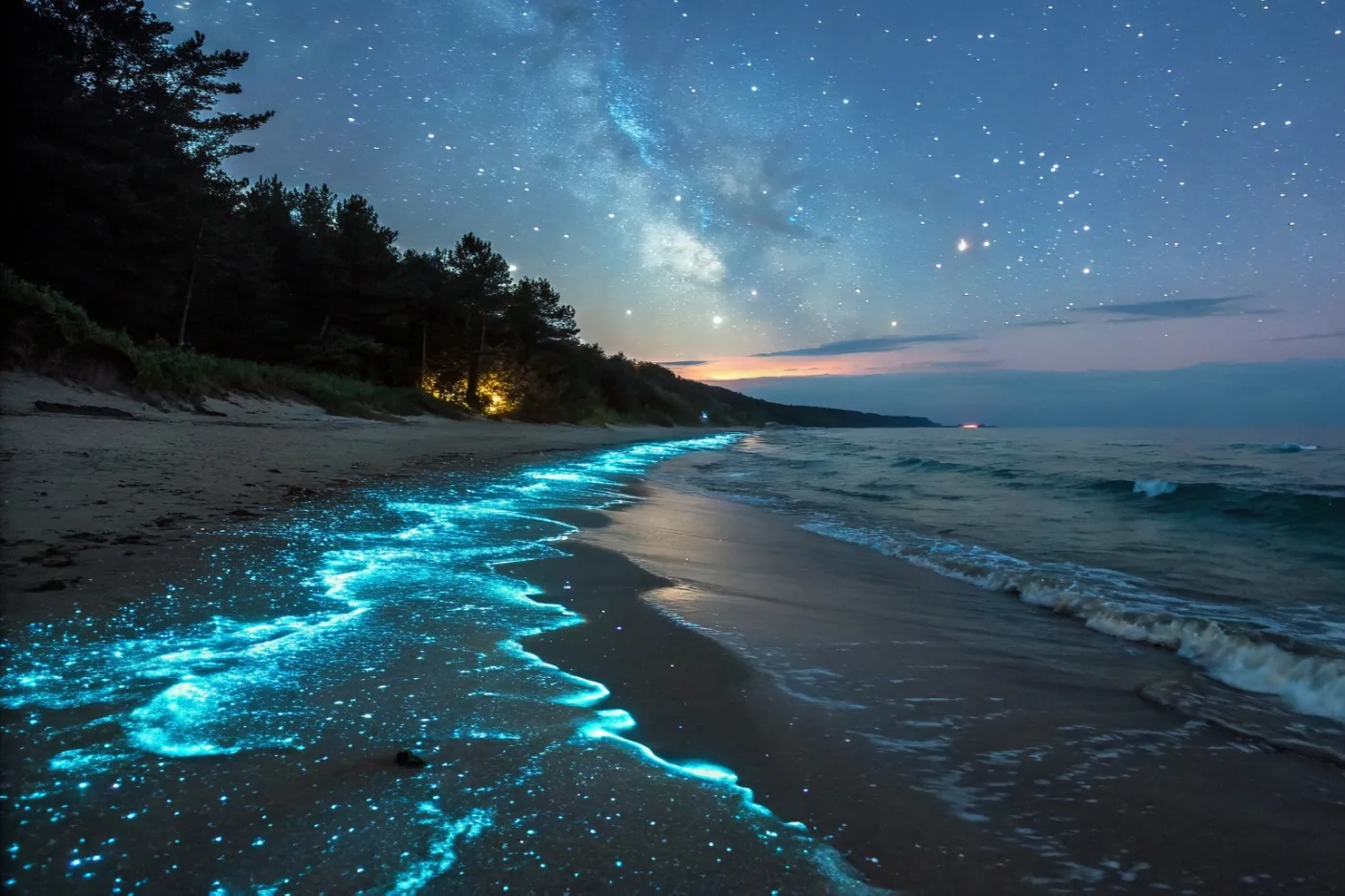Table Of Contents
Table of Contents
Have you ever imagined walking along a beach where the sand glows beneath your feet, and the water sparkles like stardust? Welcome to the enchanting world of bioluminescence beaches in USA. These magical places are a natural wonder where the night lights up the shore with a shimmering glow. Let’s dive into the science, the top spots to visit, and how to experience this phenomenon responsibly.
What is Bioluminescence?

Bioluminescence is the amazing ability of certain organisms to produce light through a chemical reaction. It’s like nature’s own magic show, where tiny creatures emit a glow to survive, communicate, or attract prey. Imagine a nighttime walk where every step around you lights up like tiny stars—this is what bioluminescence feels like.
The Science Behind the Glow
Bioluminescence is created by a chemical reaction involving luciferin and luciferase. Luciferin acts as the light-producing molecule, while luciferase is the enzyme that triggers the reaction. This process doesn’t generate heat, making it completely different from the light we get from fire or bulbs.
Organisms like plankton, certain fish, and algae use bioluminescence. When disturbed, they emit a blue-green glow. It’s a fascinating survival mechanism, helping them communicate or fend off predators in the dark ocean depths.
Best Time to Witness Bioluminescence
The perfect time to see this natural wonder varies by location. Generally, calm, warm nights are ideal. Peak seasons are often between late spring and early fall, but exact times can differ. Research the specific beaches you plan to visit for the best experience times.
Top 5 Bioluminescence Beaches in the USA
Mosquito Bay, Vieques, Puerto Rico

Mosquito Bay is a must-visit for bioluminescence enthusiasts. Known as “The Brightest Bioluminescent Bay in the World,” it’s a bucket list destination. The bay’s bioluminescence is so intense that it lights up the entire water surface, creating a surreal experience.
Location & Unique Features:
Nested on the island of Vieques, Puerto Rico, Mosquito Bay is accessible by boat tours. The bay’s phosphorescent organisms are so dense that every splash or paddle creates a glowing trail.
Peak Seasons & Visitor Tips:
The best time to visit is from March to November, with calm nights offering the most dazzling displays. Arrive early to secure your spot on a guided tour, and respect the natural environment to preserve this unique ecosystem.
Fun Fact: Mosquito Bay is home to some of the brightest bioluminescent organisms on Earth, making it a top destination for researchers and nature enthusiasts alike.
Tomales Bay, California
Tomales Bay, located north of San Francisco, offers a serene experience with its glowing waters. It’s a quieter option, perfect for those seeking a more secluded adventure. The best months to visit are from May to October when the waters are calmest.
Location & Unique Features:
Surrounded by the Point Reyes National Seashore, Tomales Bay is renowned for its crystal-clear waters and diverse marine life. The bioluminescence here is particularly striking during the summer months.
Best Months to Visit & Guided Tours:
Visitors can opt for guided kayak tours led by experienced eco-tourism operators. These tours not only offer a chance to witness the glow but also provide insights into the local marine ecosystem.
Added Activity: After your bioluminescence adventure, visitors can explore the nearby oyster farms or enjoy fresh seafood at local restaurants.
Indian River Lagoon, Merritt Island, Florida
Ideal for kayakers, Indian River Lagoon provides a chance to glide through bioluminescent waters. Best visited from April to October, it’s a haven for wildlife enthusiasts. Look out for manatees, dolphins, and even the occasional eagle as you explore.
Location & Unique Features:
Situated close to the Kennedy Space Center, Indian River Lagoon combines a unique natural and aerospace history. The lagoon’s ecosystem supports a wide range of marine species, making it a biodiversity hotspot.
Kayaking Tours & Wildlife Highlights:
Eco-friendly kayaking tours are available, offering a peaceful way to explore the lagoon’s nighttime glow. Keep an eye out for fireflies and other nocturnal creatures during your journey.
Bonus Tip: Staying at a nearby eco-lodge not only supports conservation efforts but also provides an immersive experience of the local flora and fauna.
Mission Bay, San Diego, California
Mission Bay combines urban convenience with natural beauty. The bioluminescent glow here is perfect for photography. Best visited from May to October, it’s a great spot for both day and night photography.
Location & Unique Features:
Located in the heart of San Diego, Mission Bay offers a mix of urban amenities and natural wonders. The bay’s calm waters provide ideal conditions for capturing the magical glow.
Seasonal Variations & Photography Spots:
The bioluminescence here is most vibrant during the early summer months. Visitors can enjoy photography tours led by professional photographers who share tips on capturing the best shots.
Additional Experience: After sunset, explore the nearby Embarcadero waterfront for dining and entertainment options, making it a perfect evening out.
Puget Sound, Washington
Puget Sound offers a cooler climate, making it ideal for summertime visits. The bioluminescence here is most active in late spring to early summer. Guided tours are a great way to explore this stunning area.
Location & Unique Features:
Known for its fjords and marine life, Puget Sound is a haven for nature lovers. The sound’s placid waters at night create an ethereal glow that’s hard to forget.
Weather Considerations & Local Tours:
Layered clothing is recommended due to the cooler evenings. Guided tours by local experts provide detailed insights into the area’s ecological balance and history.
Suggested Itinerary: Pair your visit to Puget Sound with a trip to nearby historical sites like the Seattle Art Museum or the Space Needle for a well-rounded experience.
How to Experience Bioluminescence Responsibly
Understanding and respecting these magical ecosystems is crucial to preserving them.
Minimizing Environmental Impact
To protect these fragile environments:
- Avoid using chemical pollutants like sunscreens or lotions that could harm the organisms.
- Do not touch or disturb the bioluminescent creatures.
- Support conservation efforts by choosing eco-friendly tour operators and accommodations.
Safety Tips for Nighttime Visits
Essentials include:
- A flashlight to navigate safely.
- Comfortable clothing and sturdy footwear.
- A guide or buddy, especially in unfamiliar areas.
Looking for more beach safety tips? Explore our guide for valuable insights.
Capturing the Glow: Photography Tips

Essential Gear for Night Photography
- Tripod: To keep your camera steady during long exposures.
- Wide-Angle Lens: To capture the vastness of the bioluminescent scene.
- Neutral-Density Filter: To manage light levels and avoid overexposure.
Camera Settings for Bioluminescence
- Manual Focus: Ensure your camera focuses on the foreground.
- Wide Aperture (f/2.8 or lower): Let in more light.
- High ISO Setting (800-1600): Enhance light sensitivity.
- Long Exposure (10-20 seconds): Capture the shimmering glow effectively.
Plan Your Visit to a Bioluminescent Beach
Thorough planning ensures you make the most of your bioluminescence adventure.
Checking Local Conditions
- Monitor algae blooms and weather forecasts for optimal visiting conditions.
- Contact local guides or parks for real-time updates on bioluminescence activity.
Booking Tours in Advance
Reserve your spot early, especially during peak seasons. Eco-friendly tour operators are preferred to support sustainability efforts.
FAQ: Everything About Bioluminescence Beaches in USA
What causes bioluminescence in the ocean?
Bioluminescence is caused by tiny organisms like plankton, algae, and certain fish emitting light through a chemical reaction. This natural light production helps them survive, communicate, or attract prey in the dark ocean depths.
Is it safe to swim in bioluminescent waters?
Generally, swimming in bioluminescent waters is safe. However, it’s essential to avoid harmful algal blooms and follow guidelines provided by local authorities or tour guides.
Can you see bioluminescent beaches during the day?
Daytime visits to bioluminescent beaches won’t reveal the same magic, as the phenomenon is most visible at night when there is less natural light.
How do I take good photos of bioluminescence?
To capture the glow, use a tripod, wide-angle lens, and long exposure settings on your camera. Adjust your ISO and aperture settings to capture the maximum light without overexposing your shots.
Conclusion
Bioluminescent beaches offer a mesmerizing glimpse into nature’s beauty. Whether you’re chasing the glow in Puerto Rico’s Mosquito Bay or photographing the magic in California, these destinations promise unforgettable experiences. Remember to respect and preserve these natural wonders so future generations can enjoy their beauty.
Embrace the Glow! Plan your trip today and discover the magic of bioluminescent beaches.


